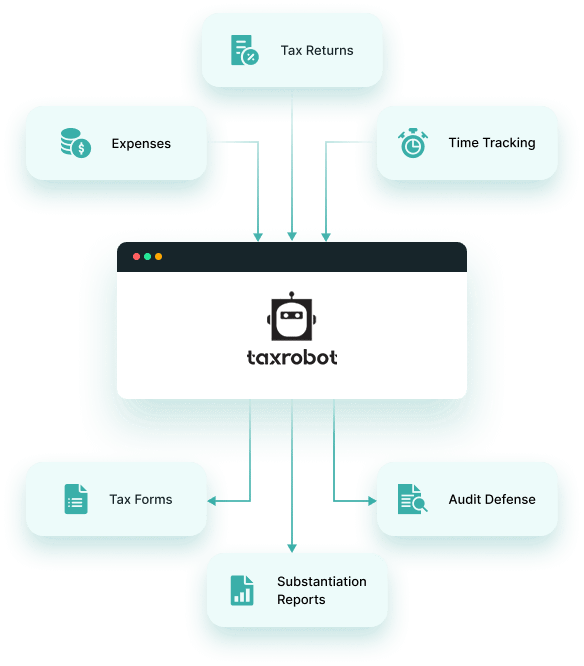Save Up to $250,000 With Our R&D Tax Credit Software
- Limited Time Offer
- Simple Onboarding
- Easy to Use



Trusted By:








Using Tax Robot
- Trusted by 100's Of Companies for Accuracy
- Quick & Easy Setup Processes
- Onboard in Minutes - Save Time Now
- Free VIP Onboarding - No Additional Fees
- Passionate In-House Customer Support
Other R&D Tax Credit Software
- Not Reliable or Accurate
- Complicated & Time Consuming
- Time Consuming Onboarding
- Hidden Fees, Upsells, Paid Addons
- Bad Outsourced Customer Support

How it Works
Provide Your Information
Link Your Systems
Receive Your Refund
Unlock the Secrets of the R&D Tax Credit.
Enter your email below for our Free R&D Playbook,

Why TaxRobot?
R&D Tax Credit Experts
TaxRobot was founded by subject matter experts with experience running an R&D tax advisory firm delivering millions of dollars to hundreds of clients nation-wide.
Audit Defense
We don’t make excuses – we stand behind our work. In the event of an audit, we’ll step in to handle questions and respond to requests.
Value-Based Pricing
We don’t get paid unless you do. If you don’t receive a tax credit, we don’t charge a fee.
Bigger Refunds
Our expertise allows us to identify benefit where others fail to. Our clients have seen up to 3X the amount of tax credit compared with competing consultants and software products.
Save Time
We value your time. Let our algorithms do the heavy lifting so you can get back to what you do best – running your business.
Superior Documentation
Our audit-proof paperwork satisfies all statutory and IRS-recommended reporting requirements.
TaxRobot's R&D tax software for CPAs and accountants
Maximize your clients’ R&D tax credits with our cutting-edge software. Streamline your R&D tax claim process today and save your valuable time. Don’t miss out on this opportunity to elevate your practice and stay ahead of the competition!
What can the R&D tax credit do for your business?
R&D tax credits can provide a significant reduction in a business’s tax liability, freeing up more resources for growth and investment.
By incentivizing innovation and experimentation, R&D tax credits can encourage businesses to develop new products, services, and processes that can improve their competitiveness and profitability.
R&D tax credits can also help businesses to attract and retain top talent by demonstrating a commitment to innovation and investment in research and development.

What Industries Quality For R&D Tax Credit ?
The eligibility of a business for R&D tax credits depends on a variety of factors, such as the nature of the research activities, the types of expenses incurred, and the documentation and record-keeping requirements. It is always recommended to consult with a tax professional or R&D tax credit specialist to determine if your business qualifies.
Software and technology
Pharmaceutical and life sciences
Manufacturing
Aerospace and defense Four
Architecture and engineering
Energy and utilities
Food and beverage
Agriculture and farming
R&D Tax Credits FAQs
The four-part test as outlined in the Internal Revenue Code is used to determine qualified R&D activity.
The Four-Part Test
1). New Or Improved Business Component
Creation of a new product, process, formula, invention, software, or technique; or improving the performance, functionality, quality, or reliability of existing business component.
- Construction of new buildings or renovation of existing buildings
- Invention of a software application
- Manufacturing of a new product or the improvement of the production process for an existing product
- Creation of design documentation
2). Technological In Nature
The activity fundamentally relies on principles of the physical or biological sciences, engineering, or computer science. A taxpayer does not need to obtain information that exceeds, expands or refines the common knowledge of skilled professionals in a particular field.
- Physics (relationship between mass, density and volume; loading as the
result of gravitational attraction) - Engineering (mechanical, electrical, civil, chemical)
- Computer science (theory of computation and design of computational systems)
3). Elimination Of Uncertainty
Uncertainty exists if the information available to the taxpayer does not establish the capability or method for developing or improving the business component, or the appropriate design of the business component.
- The capability of a manufacturer to create a part within the specified tolerances
- The appropriate method of overcoming unsuitable soil conditions during construction
- The appropriate software design to meet quality and volatility requirements
4). Process Of Experimentation
A process designed to evaluate one or more alternatives to achieve a result where the capability or method of achieving that result, or the appropriate design of that result, is uncertain as of the beginning of the taxpayer’s research activities.
- Systematic process of trial and error
- Evaluating alternative means and methods
- Computer modeling or simulation Prototyping Testing
The R&D tax credit is one of the most misunderstood tax incentives available. Considering the myriad of industries and activities that legally qualify for the credit, the term “research and development” is a misnomer. Additionally, the R&D tax credit requires specialized knowledge and technology to identify and calculate the incentive properly.
Companies of various industries are unaware that they are eligible to claim the R&D tax credit. Under the Internal Revenue Code’s definition of R&D, many common activities qualify. You can get tax benefits for industries including software, technology, architecture, engineering, construction, manufacturing, and more.
The R&D tax credit can be claimed for all open tax years. Generally, open tax years include the prior three tax years due to the statute of limitations period. In certain circumstances, the law allows businesses to claim the R&D tax credit for an extended period of time. It is common for companies to amend previous tax years to claim this benefit and reduce the maximum amount of tax liability.
Partnerships and S corporations must file this form to claim the credit. The credit will flow from the Form 6765, to the Schedule K-1, to the Form 3800 on the individual’s tax return. For individuals receiving this credit that have ownership interest in a partnership or S corporation, Form 6765 is not required on the individual return.
Individuals claiming this credit can report the credit directly on Form 3800, General Business Credit if their only source for the credit is a partnership, S corporation, estate, or trust. Otherwise, Form 6765 must be filed with the individual’s tax return (e.g. sole proprietorship).
For tax years prior to 2016, the credit can be used to reduce the taxpayer’s regular tax liability down to the tentative minimum tax. The credit cannot be used to offset alternative minimum tax. Beginning in tax year 2016, eligible small businesses have expanded utilization for the credit. For these eligible small businesses, the regular tax liability can offset alternative minimum tax using the “25/25” rule.